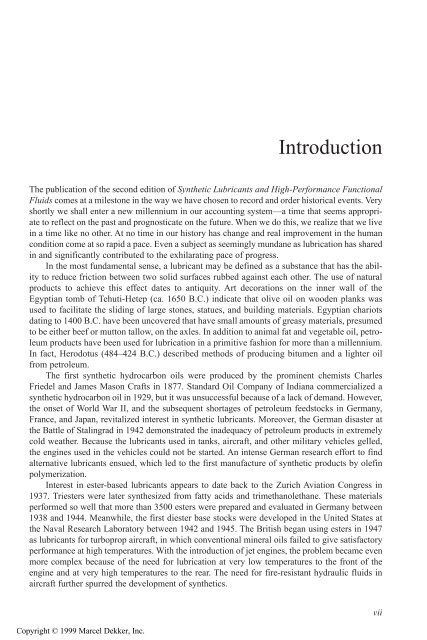SYNTHETIC LUBRICANTS AND HIGH-PERFORMANCE ...
SYNTHETIC LUBRICANTS AND HIGH-PERFORMANCE ...
SYNTHETIC LUBRICANTS AND HIGH-PERFORMANCE ...
You also want an ePaper? Increase the reach of your titles
YUMPU automatically turns print PDFs into web optimized ePapers that Google loves.
Introduction<br />
The publication of the second edition of Synthetic Lubricants and High-Performance Functional<br />
Fluids comes at a milestone in the way we have chosen to record and order historical events. Very<br />
shortly we shall enter a new millennium in our accounting system—a time that seems appropriate<br />
to reflect on the past and prognosticate on the future. When we do this, we realize that we live<br />
in a time like no other. At no time in our history has change and real improvement in the human<br />
condition come at so rapid a pace. Even a subject as seemingly mundane as lubrication has shared<br />
in and significantly contributed to the exhilarating pace of progress.<br />
In the most fundamental sense, a lubricant may be defined as a substance that has the ability<br />
to reduce friction between two solid surfaces rubbed against each other. The use of natural<br />
products to achieve this effect dates to antiquity. Art decorations on the inner wall of the<br />
Egyptian tomb of Tehuti-Hetep (ca. 1650 B.C.) indicate that olive oil on wooden planks was<br />
used to facilitate the sliding of large stones, statues, and building materials. Egyptian chariots<br />
dating to 1400 B.C. have been uncovered that have small amounts of greasy materials, presumed<br />
to be either beef or mutton tallow, on the axles. In addition to animal fat and vegetable oil, petroleum<br />
products have been used for lubrication in a primitive fashion for more than a millennium.<br />
In fact, Herodotus (484–424 B.C.) described methods of producing bitumen and a lighter oil<br />
from petroleum.<br />
The first synthetic hydrocarbon oils were produced by the prominent chemists Charles<br />
Friedel and James Mason Crafts in 1877. Standard Oil Company of Indiana commercialized a<br />
synthetic hydrocarbon oil in 1929, but it was unsuccessful because of a lack of demand. However,<br />
the onset of World War II, and the subsequent shortages of petroleum feedstocks in Germany,<br />
France, and Japan, revitalized interest in synthetic lubricants. Moreover, the German disaster at<br />
the Battle of Stalingrad in 1942 demonstrated the inadequacy of petroleum products in extremely<br />
cold weather. Because the lubricants used in tanks, aircraft, and other military vehicles gelled,<br />
the engines used in the vehicles could not be started. An intense German research effort to find<br />
alternative lubricants ensued, which led to the first manufacture of synthetic products by olefin<br />
polymerization.<br />
Interest in ester-based lubricants appears to date back to the Zurich Aviation Congress in<br />
1937. Triesters were later synthesized from fatty acids and trimethanolethane. These materials<br />
performed so well that more than 3500 esters were prepared and evaluated in Germany between<br />
1938 and 1944. Meanwhile, the first diester base stocks were developed in the United States at<br />
the Naval Research Laboratory between 1942 and 1945. The British began using esters in 1947<br />
as lubricants for turboprop aircraft, in which conventional mineral oils failed to give satisfactory<br />
performance at high temperatures. With the introduction of jet engines, the problem became even<br />
more complex because of the need for lubrication at very low temperatures to the front of the<br />
engine and at very high temperatures to the rear. The need for fire-resistant hydraulic fluids in<br />
aircraft further spurred the development of synthetics.<br />
Copyright © 1999 Marcel Dekker, Inc.<br />
vii
















